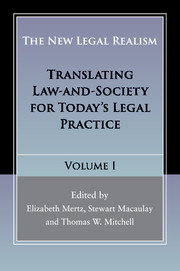Book contents
- Frontmatter
- Contents
- List of contributors
- Preface to The New Legal Realism, Volumes I and II
- 1 Introduction: New Legal Realism: Law and Social Science in the New Millennium
- Section I THE PLACE OF NEW LEGAL REALISM IN LEGAL THOUGHT AND TEACHING
- 2 A New Legal Realism: Elegant Models and the Messy Law in Action
- 3 Putting the “Real World” into Traditional Classroom Teaching
- 4 Some Realism about Realism in Teaching about the Legal Profession
- 5 “Fielding” Legal Realism: Law Students as Participant-Observers?
- Section II PHILOSOPHY AND METHODS FOR A NEW LEGAL REALISM
- Section III NEW LEGAL REALIST TRANSLATIONS
- Index
- References
2 - A New Legal Realism: Elegant Models and the Messy Law in Action
from Section I - THE PLACE OF NEW LEGAL REALISM IN LEGAL THOUGHT AND TEACHING
Published online by Cambridge University Press: 05 May 2016
- Frontmatter
- Contents
- List of contributors
- Preface to The New Legal Realism, Volumes I and II
- 1 Introduction: New Legal Realism: Law and Social Science in the New Millennium
- Section I THE PLACE OF NEW LEGAL REALISM IN LEGAL THOUGHT AND TEACHING
- 2 A New Legal Realism: Elegant Models and the Messy Law in Action
- 3 Putting the “Real World” into Traditional Classroom Teaching
- 4 Some Realism about Realism in Teaching about the Legal Profession
- 5 “Fielding” Legal Realism: Law Students as Participant-Observers?
- Section II PHILOSOPHY AND METHODS FOR A NEW LEGAL REALISM
- Section III NEW LEGAL REALIST TRANSLATIONS
- Index
- References
Summary
Recently there has been a flurry of interest in empirical approaches to law among legal scholars. Some of them talk of a “new legal realism,” although it is unclear whether they mean similar things. Some want to study the “law in action” – that is, the operation of trial courts, the exercise of discretion by various legal officials, as well as what it is that lawyers actually do. Others want to add a consideration of the “living law” – the norms and sanctions that people in various groups respond to other than official law. Sometimes the living law is in competition with the official law; sometimes they exist in a complicated interrelationship, and the living law may support the formal law to some degree.
Of course, such concerns are not entirely “new.” We can list many earlier examples of empirical work on law. For example, we can recall Charles Clark's studies of the business of courts, the University of Chicago jury project, and the University of Wisconsin's Civil Litigation Research Project from earlier times (see the studies cited in Macaulay 2005 and Nourse and Shaffer 2009, which offer many examples of calls for a new legal realism). Indeed, two of my own empirical projects were published more than 50 (Macaulay 1963) and 35 (Macaulay 1979) years ago. However, while we can cite such older examples, people in law schools have spent more time talking about the law in action than they have spent actually doing such research. Yet things may be changing. Indeed, recently some traditional law professors seem threatened by the demands that we go on beyond doctrine.
I want to tell three stories. First, I will describe some of the recent interest by law professors in empirical approaches to law. It comes in very distinct flavors, and it is not just more of what has been done in the past. As I offer examples, I will note some of the problems faced by those who seek to apply social science techniques to the operations of the legal system. There is no perfect way to study the law in action or the living law. All methods have their limits. Second, I will look at the challenges that we who do not have PhDs in any social science face when we seek help from our colleagues who do this kind of work.
- Type
- Chapter
- Information
- The New Legal RealismTranslating Law-and-Society for Today's Legal Practice, pp. 29 - 50Publisher: Cambridge University PressPrint publication year: 2016
References
- 3
- Cited by



